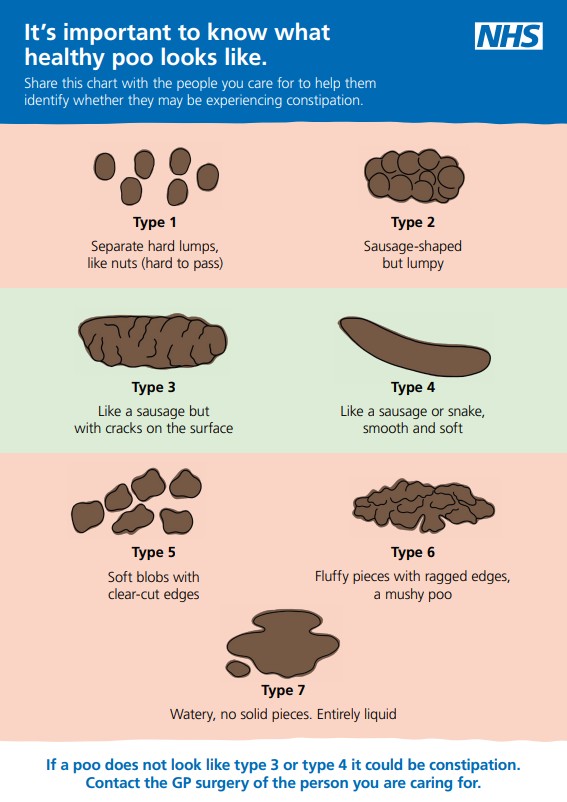What is constipation
Constipation is difficulty passing poo (stool) or the infrequent passing of poo (fewer than three spontaneous bowel movements per week may indicate constipation). It usually happens when poo stays in the bowel too long and becomes hard, dry, and painful to pass.
Why constipation is more common in autistic people?
- Many autistic people have restricted diets or avoid certain textures.
- Due to interoception some people don’t recognise thirst and therefore forget to drink enough or even dislike the taste of water
- Sensory differences can make eating enough fibre, drinking enough fluids, or using the toilet more difficult
- Some medications can cause constipation
- Changes in routine, stress, or unfamiliar toilets can affect bowel movements
- Some people may not notice they are constipated, symptoms of constipation or be able to describe physical discomfort easily
Example: An autistic person may only eat dry foods like crackers and avoid fruit or vegetables, which can lead to constipation.
Signs of constipation
- Fewer bowel movements than usual
- Hard, dry, or painful poo
- Stomach pain or bloating
- Feeling like you haven’t fully emptied your bowels
- Changes in mood or behaviour
- Straining or avoiding the toilet
If you feel anxious or irritable you may not realise it’s because you haven’t had a bowel movement in several days.
Constipation in autistic children
Constipation can delay toilet training and affect both bowel and bladder control. It can also cause pain and anxiety for children and their families.
Common causes of constipation
- Eating a limited range of foods
- Underlying health condition
- Certain medications
- Withholding poo after a painful experience
- Sensory issues with passing poo
- Children preferring to poo in a nappy due to routine or comfort
- Forgetting to drink, disliking water or not drinking enough
- Feeling anxious about using the toilet, especially away from home or disrupted routine
How to spot constipation

- A normal pattern is soft, sausage-shaped poo at least 3 times a week – type 4 on Bristol stool chart
- Watch for changes in bowel habits, especially during routine changes (e.g. holidays, starting school, new job)
- Large, painful poos, a swollen or painful tummy and any change in behaviour – as this may be due to pain or discomfort due to pain
- Irritability, poor sleep, or reduced appetite
What is overflow soiling?
If poo stays in the bowel too long, it becomes hard and dry. This can block the bowel. Softer poo may leak around the blockage. This is called overflow soiling. It is not diarrhoea.
- The leaked poo may be smelly and hard to clean
- You may not feel the urge to go because the bowel is stretched
- Constipation can also affect bladder control, in children this could be the underlying cause of bedwetting
What helps?
For all ages:
- Eat more fibre: Gradually add small amounts of fibre in the form of fruit, vegetables, or whole grains
- Drink more fluids: Offer or sip water or other drinks which are enjoyed (e.g. could be squash/dilute) regularly throughout the day
- Move more: Gentle movement like walking or stretching helps digestion
- Use a regular toilet routine: Try going at the same time each day
- Use a toileting position to help open bowels easier. Feet raised up on a stool or books (knees above hips and sitting forward to elbows on knees) to help.
- Make the toilet space comfortable: Adjust lighting, sounds, or smells
- Use visuals: Charts or reminders can help build habits
Example: You could use a visual or digital reminder or checklist to remember to drink water, eat a fibre snack, and sit on the toilet after breakfast.
Medical support
- Speak to a GP if constipation lasts more than 3 days or causes any pain, abdominal swelling or distress
- A check-up is usually enough—further tests are rarely needed
- Let the GP know about you, or your child is autistic and what reasonable adjustments are needed to support the appointment
Medication and treatment
- Treatment often starts with disimpaction (clearing the bowel)
- This is followed by maintenance (keeping the bowel empty)
- Treatment which maybe short term or needed long-term meaning it could last for several months or longer
- There is a range of medication options- return to the GP if the medicine is not something that you or your child can accept the taste of and take regularly
Sensory support
Constipation can be harder to manage if you experience sensory differences, anxiety, or difficulties with routines.
- Break tasks into small steps (e.g. go to the toilet, sit for 5 minutes, try to relax)
- Use distractions like music or fidget toys to help you feel calm
- Try abdominal (tummy) massage if helpful
- Adjust the toilet space to suit your needs (e.g. balance, smell, sound, light)
- Keep the environment calm and predictable
- For children, use stories, pictures, games, or rewards to build confidence for children.
Click here for more information about toilet training children on Autism Space.
Example: A child might feel more relaxed using a toilet at home with a favourite toy and soft lighting. Or an adult in a workplace might use noise-cancelling headphones and a lavender-scented cloth to feel more relaxed in a public toilet.
Emotional support
For adults
- Remind yourself that constipation is common and not your fault
- Talk to someone you trust if you feel anxious or embarrassed
- Ask for support with appointments or help managing medication if needed
- Let others know what helps you feel safe and comfortable
Example: You might ask for help to plan meals with more fibre
For helping children
- Reassure them that it’s OK to feel worried
- Let them know they are not being “naughty” or “difficult”
- Help them understand what is happening in their body
- Support them to build trust and confidence over time
Summary:
Constipation can be painful and upsetting, especially for autistic people. It can affect how someone feels, sleeps, eats, and uses the toilet. Eating more fibre, drinking enough fluids, keeping a regular toilet routine, and making the toilet space comfortable can all help. If constipation doesn’t get better or causes pain, it’s important to speak to a doctor


